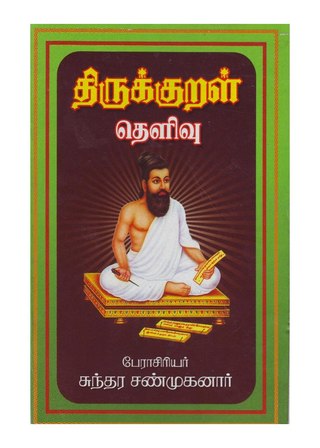| Part of a series on |
| Translation |
|---|
 |
| Types |
| Theory |
| Technologies |
| Localization |
| Institutional |
| Related topics |
|
As of 2015, Tirukkural has been translated into Sinhalese at least twice. [1]
| Part of a series on |
| Translation |
|---|
 |
| Types |
| Theory |
| Technologies |
| Localization |
| Institutional |
| Related topics |
|
As of 2015, Tirukkural has been translated into Sinhalese at least twice. [1]
The first Sinhalese translation of the Tirukkural was made by Govokgada Misihamy, [2] with the assistance of S. Thambaiah, in 1961 under the title Thiruvalluvar's Kural, who considered his translation an 'adaptation' rather than a translation for he believed that no translation of any classic into a foreign language can do justice to the original. [3]
Another translation of the Kural text was made by Charles De Silva in 1964, which was published by the Sri Lanka Sahitya Mandalaya. [2] [3]
| Translation | Chapter 26, මස් කෑමෙන් වැළකීම | |
|---|---|---|
| Kural 254 (Couplet 26:4) | Kural 258 (Couplet 26:8) | |
| Govokgada Misihamy, 1961 | කූළුණ සහනු කූළුණ - පර පණ රැකූම නැසුමයි එහෙයින් පණ නැසුව - සිරුරෙ මස් කෑම අදහම් වේ. | වරදින් මිදි ඇති - පැහැදිලි දැනුම් ඇත්තෝ අනෙකකූගේ සිරුරේ - මසක් නුබුදිති කිසිම ලෙසකින්. |

The Tirukkuṟaḷ, or shortly theKural, is a classic Tamil language text consisting of 1,330 short couplets, or kurals, of seven words each. The text is divided into three books with aphoristic teachings on virtue (aram), wealth (porul) and love (inbam), respectively. It is widely acknowledged for its universality and secular nature. Its authorship is traditionally attributed to Valluvar, also known in full as Thiruvalluvar. The text has been dated variously from 300 BCE to 5th century CE. The traditional accounts describe it as the last work of the third Sangam, but linguistic analysis suggests a later date of 450 to 500 CE and that it was composed after the Sangam period.
Tirukkural, also known as the Kural, an ancient Indian treatise on the ethics and morality of the commoner, is one of the most widely translated non-religious works in the world. Authored by the ancient Tamil poet-philosopher Thiruvalluvar, the work has been translated into 57 languages, with a total of 350 individual translations, including 143 different renderings in the English language alone.

Tirukkural remains one of the most widely translated non-religious works in the world. As of 2014, there were at least 57 versions available in the English language alone. English, thus, continues to remain the language with most number of translations available of the Kural text.
Kannada has at least eight translations of the Tirukkural available as of 2014. Both prose and verse translations have been made in Kannada.
As of 2015, there are at least two translations of the Tirukkural available in the Polish language.
As of 2024, there were at least five translations of the Tirukkural available in Arabic. The Kural text is the first, and so far the only, Tamil work to be translated directly into Arabic. It is also the first Tamil work to be released in the Arabian soil.
As of 2015, the Chinese language had two translations available of the Tirukkural.
As of 2015, the Japanese language has two translations available of the Tirukkural.
Malayalam has seen the most number of Tirukkural translations than that of any other language in India. As of 2007, there are at least 21 translations of the Kural text available in Malayalam. Malayalam also has the distinction of producing the first ever translation of the Kural text among the languages in India and the world at large. The Annual Report of the Cochin Archeological Department for the year 1933–34 reported an unpublished manuscript of a Malayalam translation of the Tirukkural made in 1595.
Telugu is one of the Indian languages that has had the earliest Tirukkural translations in modern times. As of 2000, there were at least 14 translations of the Kural text available in Telugu.
As of 2015, there were at least three Gujarati translations available of the Tirukkural.
As of 2015, there were at least five Sanskrit translations available of the Tirukkural 724 into sanskrit
As of 2015, Tirukkural has been translated into Rajasthani only once.
As of 2015, Tirukkural has been translated into Saurashtra only once.
As of 2015, Tirukkural has been translated into Czech only once.
As of 2015, Tirukkural has been translated into Dutch only once.
As of 2015, there is only one translation of the Tirukkural available in Swedish.
As of 2023, Konkani has three translations available of the Tirukkural.
As of 2015, Fijian had at least two translations available of the Tirukkural.
E. S. Ariel, also referred to as Monsieur Ariel by his contemporaries, was a 19th-century French translator known for his French translation of the ancient Indian philosophical text of the Tirukkural. He translated select couplets of the Tirukkural into French in 1848 and published it in Paris under the title Kural de Thiruvalluvar . Although the first French translation of the Kural text was made by an unknown author in 1767, which Ariel had mentioned in his work, it was Ariel's translation that brought the ancient work to the French world.
{{cite journal}}: CS1 maint: DOI inactive as of November 2024 (link)